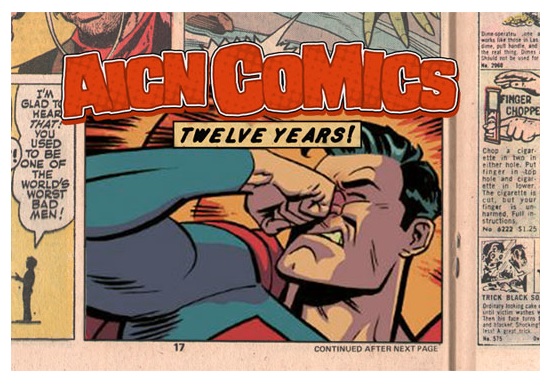
(Click title to go directly to the review)
Advance Review: SECRET ORIGINS #1
ULTIMATE FF #1
JUSTICE LEAGUE #29
ALL-NEW DOOP #1
Indie Jones presents THE HAWK OF NEW YORK #1
SUPERIOR SPIDER-MAN #31
BATMAN #30
THOR: GOD OF THUNDER #21
SHE-HULK #3
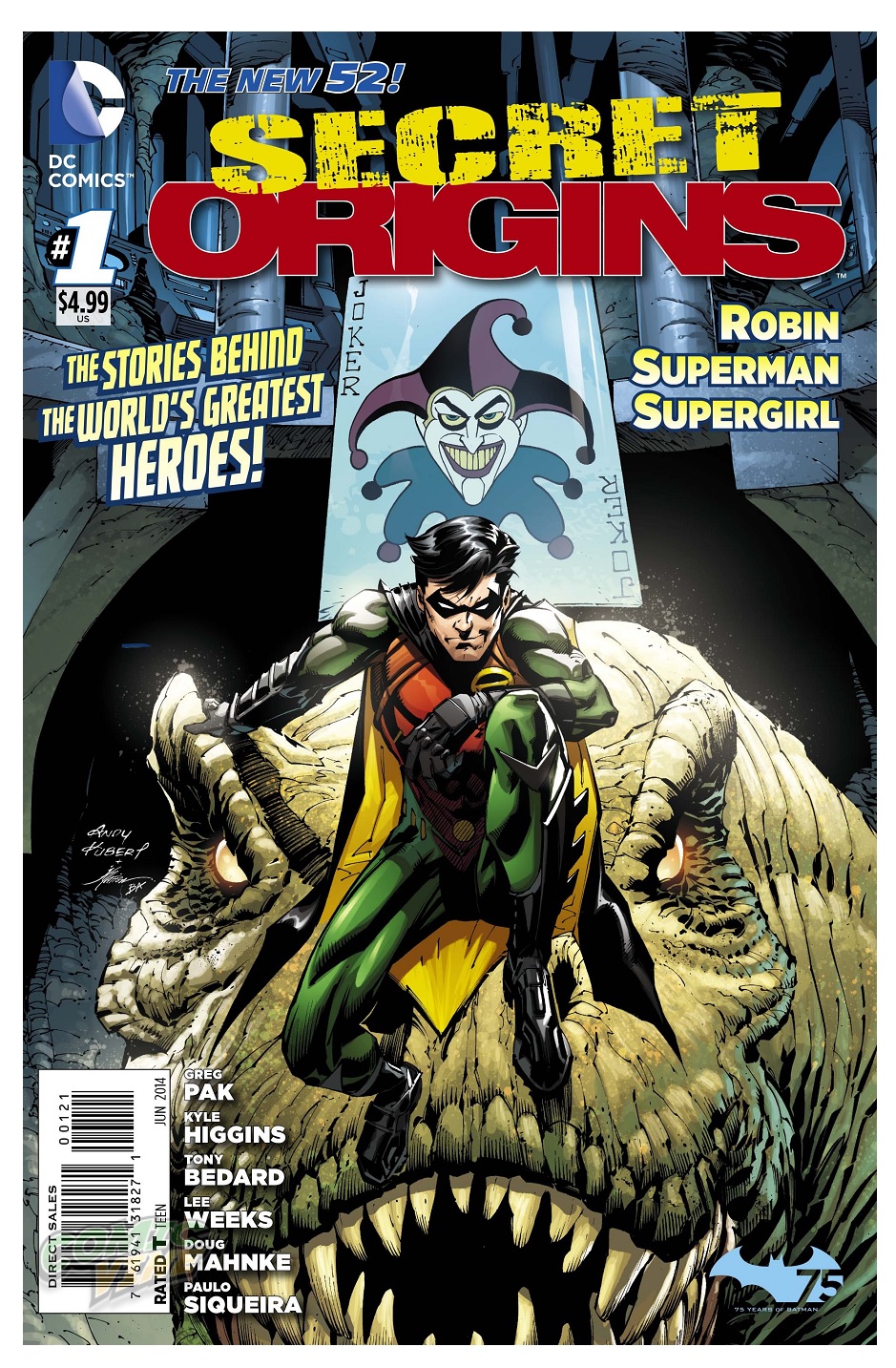 Advance Review: In stores today!
Advance Review: In stores today!SECRET ORIGINS #1
Writers: Greg Pak, Kyle Higgins, Tony BedardArtists: Lee Weeks, Doug Mahnke, Paulo Siqueira
Publisher: DC Comics
Reviewer: Optimous Douche
SECRET ORIGINS were a godsend to a young Optimous some 30 odd years ago. When I started reading DC comics, during the demise of the multiverse in CRISIS ON INFINITE EARTHS, I understood the broad swaths of super heroics, but none of the subtle nuances. Deep dive characterization within the pages of SECRET ORIGINS helped me discern between a Clayface and a Parasite.
The new SECRET ORIGINS isn’t skulking in such character shadows, instead heralding the origin subtleties of heavy hitters like Superman, Robin (Dick Grayson) and Supergirl, but the spirit of yore is alive an well.
DC is rebuilding origins right now, with this title and “Zero Year” as the indelible proof. Is it needed? Yes, the half-decade dance between titles infuriated longtime fans and confused the noobs. You know, confused is the wrong word. When the New 52 launched it was as if we were thrust deep into the lives of people we only sort of knew. I’ll never say EVERY story needs to start at birth, but when characters are so singularly driven some level of context or an inciting event is required to make these hyperboles of personality believable.
If you’re a strapped for cash comic reader and have been dying to take your first foray into the New 52, SECRET ORIGINS is the economical and enjoyable choice. It skips the bloat of filler issues and introduces you to new origin twists that have delineated this universe from its FLASHPOINT predecessor:
Superman’s origin is one that even non-comic fans are able to recite by rote. However, Pak uses the same patented personalization to retell the origin from the same unique perspective that has made his ACTION run the best Superman stories of the New 52. This is the narration of two mothers, Lara-El and Martha Kent. Both women are fierce protectors, but they are also uniquely different ladies. The New 52 has put a firm stake in the ground: the ladies of El are the warriors, while the men are the kitchen bitches at home cooking up experiments with crystals. This essentially has made Lara-El a true career woman and given her a dimension beyond simply swooning over Jor-El and his big science brain. Martha was simply always meant to be a mother and embraces this child from the stars as her own, despite the fear instilled by his burgeoning powers. This truly was a beautiful piece, but I also truly expect no less from Pak at this point.
Robin’s origin is a little more by the numbers--it’s good, but it could live in old or new 52 alike. We all know the deal: Dick’s parents are killed by Zucco, he wants vengeance, fucks up, and is then adopted by Bruce Wayne. The nice addition to this one was the application of symbolism to the Robin mantle. The Robin means rebirth and was also his mother’s favorite symbol. It takes Dick some time to remember this triviality of his Mom’s existence, but when the moment comes together it is very sweet and endearing.
Supergirl’s origin is required reading in my opinion. Bedard successfully truncates some very key elements in Kara-El’s life that were somewhat muddy in the actual books. If you read every issue (which I have), this story doesn’t offer anything exceptionally new. If you haven’t read past issues (like most folks), there are some origin must-haves that I believe will be very important moving forward for the entire DCU. Kara is becoming a major player in the Superman and GL universes, so it’s important to understand how different she is from Kal and the muddled mess she went through to get to Earth.
I’m a fan of SECRET ORIGINS, because I need constant reminders of minutia. There were several very distinct “Damn, I forgot about that” moments while I was reading. Again, if you’re jumping into DC for the first time, SECRET ORIGINS is a more required read than any of the starter issues that launched the universe. If you’ve been on the ride all along, SECRET ORIGINS is truly for the DC Superfan.
Optimous Douche has successfully blackmailed BottleImp to draw purty pictures for his graphic novel AVERAGE JOE coming out in 2013 from COM.X. When not on Ain’t It Cool, Optimous can be found talking comics and marketing on robpatey.com and just marketing on MaaS360.com.
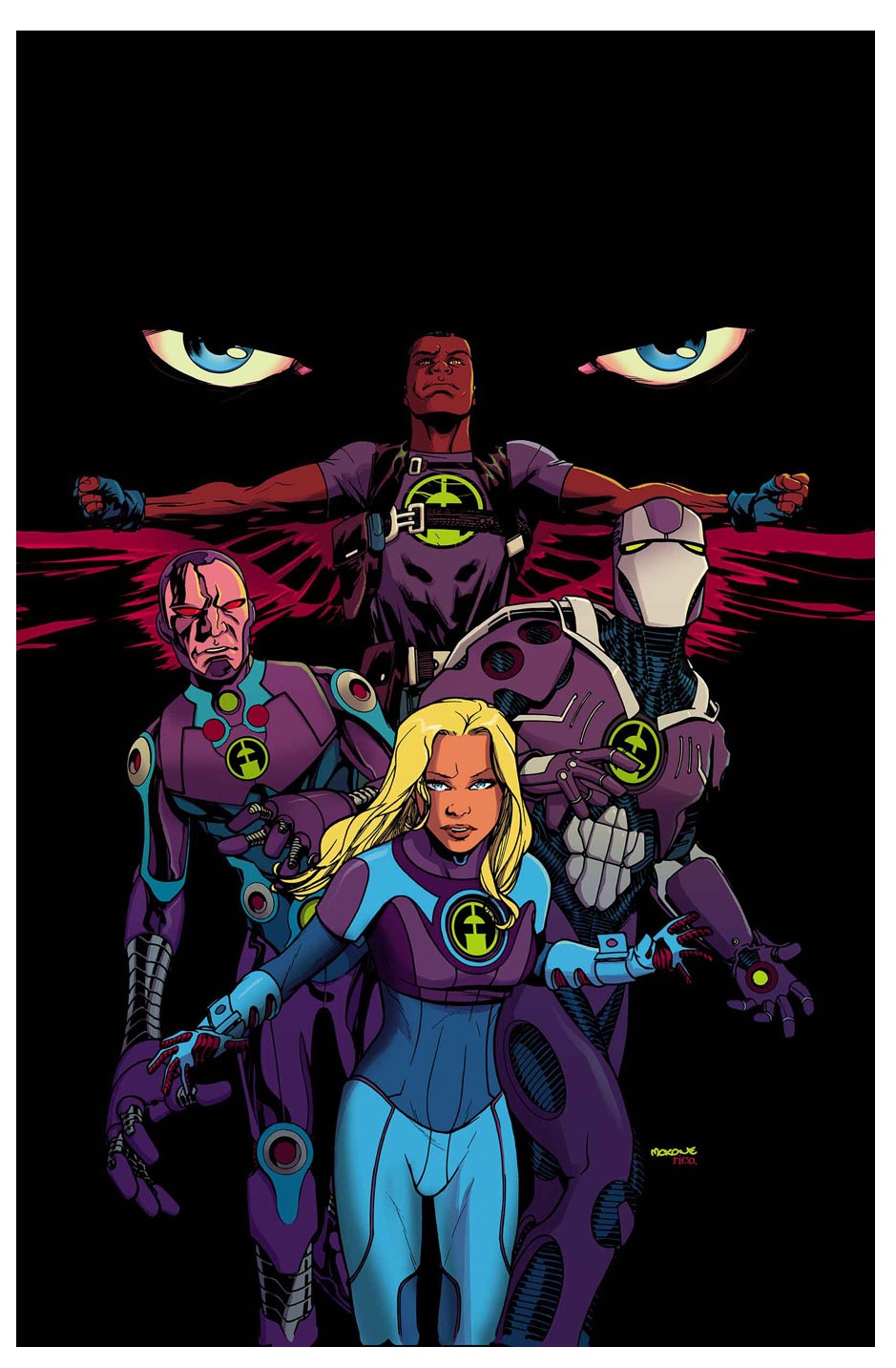
ULTIMATE FF #1
Writer: Joshua Hale FialkovPencilers: Mario Guevara with Tom Grummett
Publisher: Ultimate Marvel Comics
Reviewer: Corey Michael Dalton
When the only two things you like about a comic book are the front cover and the colors, you know you're in trouble. Such is the case with ULTIMATE FF #1, yet another failed opportunity by Marvel to launch a new title in its once-relevant Ultimate line of comics. Remember when Mark Millar's ULTIMATES and Brian Michael Bendis' ULTIMATE SPIDER-MAN were two of the most popular titles being published? What ever happened to that Ultimate line? (I'm sure many people would say "Jeph Loeb happened.")
But I digress. I am not here to discuss the long, slow death of the Ultimate line in general; merely its latest weak entry, ULTIMATE FF. Let's start with the good. How 'bout that cover by Mike McKone, huh? Kind of cool. Interesting collection of characters. Clean logo. Intriguing, semi-villainous color scheme. Calls to mind the video for Queen's "Bohemian Rhapsody." The cover was good enough to make me shell out $4 for 20 pages of story. Why didn't I heed that old adage "Never judge a book by its cover"?
The interior art is, to put it nicely, a mess. The linework is sketchy, characters seem to be placed at random on the page like Colorforms, feet are either non-existent or extremely Liefeldian, the panel-to-panel storytelling is confusing, and faces are often distorted or lopsided. And don't even get me started on the character designs. Is Falcon wearing a do-rag over half of his face? With camo pants? Does Doctor Doom have mechanical goat legs? (That really only works for Darth Maul, Victor.) And could the monsters be more generic? They're just blobby things with teeth. On top of all of that, the stylized "FF"s on the characters' chests look like a single "A" instead of two "F"s. Two artists are credited as pencilers (Mario Guevara and Tom Grummett), which is never a good sign. One has to wonder if Marvel received the pencils from Guevara, realized that they were not up to snuff, and asked Grummett, an old pro, to try to fix them. Alas, the fix did not take. The one bright spot in the art is the coloring by Rachelle Rosenberg. Her use of secondary colors in place of the traditional primary comic book colors sets the comic apart from others on the stands and lends it a slightly off-kilter mood.
I haven't even addressed the writing yet. I usually begin my reviews discussing the plot, characterization, dialogue, etc., but the writing in this issue by Fialkov (or is it Hale Fialkov?) was so bland that I just don't have a whole lot to say about it. The plot was pretty much nonexistent—a team of random characters (the Invisible Girl, Iron Man, and Falcon) stares into a big blue blob while the team members bicker, then some cheesy monsters attack them. Occasionally the team gets advice from Machine Man and Phil Coulson (for some reason), both of whom remain seated at desks throughout most of the issue. And then Doctor Doom shows up on the last page, which is supposed to be a surprise even though the title of the issue is "DOOMED" (yes, in all caps). There were some attempts at witty dialogue, but they came off as forced and made the characters seem either extremely annoying (Tony, I'm looking squarely at you) or shrewish (Susan). In fact, most of the characters (save Falcon, who only got a few lines) came across as overly snarky and not nearly as clever as they wanted to be. Perhaps introducing your characters alongside their fictional IQs may not be the best way to endear them to your readers. (I get it: this a team of geniuses. Well, who ever liked geniuses?!) Also, I wish someone would ban Marvel's writers from using "&*%$" in place of curse words. Either print the word or don't. Trying to have your cake and eat it too just comes across as juvenile. Fialkov uses symbols like this six times in this issue. Honestly, with the one-note dialogue, the dearth of tension, the lack of forward momentum, and the obvious "surprise" ending, I had trouble staying engaged long enough to even finish the 20 pages.
Look, I know no one sets out to make a bad comic, so I really don't want to harp on the creative team here too much. I'm sure they're all competent professionals and will create awesome, enjoyable comics down the road. ULTIMATE FF just ain't one of those comics, unfortunately. Maybe we should blame the editor, Mark Paniccia? No matter who's to blame, this issue is simply not good. In fact, if this were grade school, I would give this title an F. And then another F. Sorry, couldn't help myself …
Corey Michael Dalton has written and/or edited trade books, magazine articles, short stories, novels, comics, plays, radio shows, reviews, websites, blogs, and more. You name it, he's probably written it. Except religious scriptures. He hasn't gotten around to those just yet. Soon ...
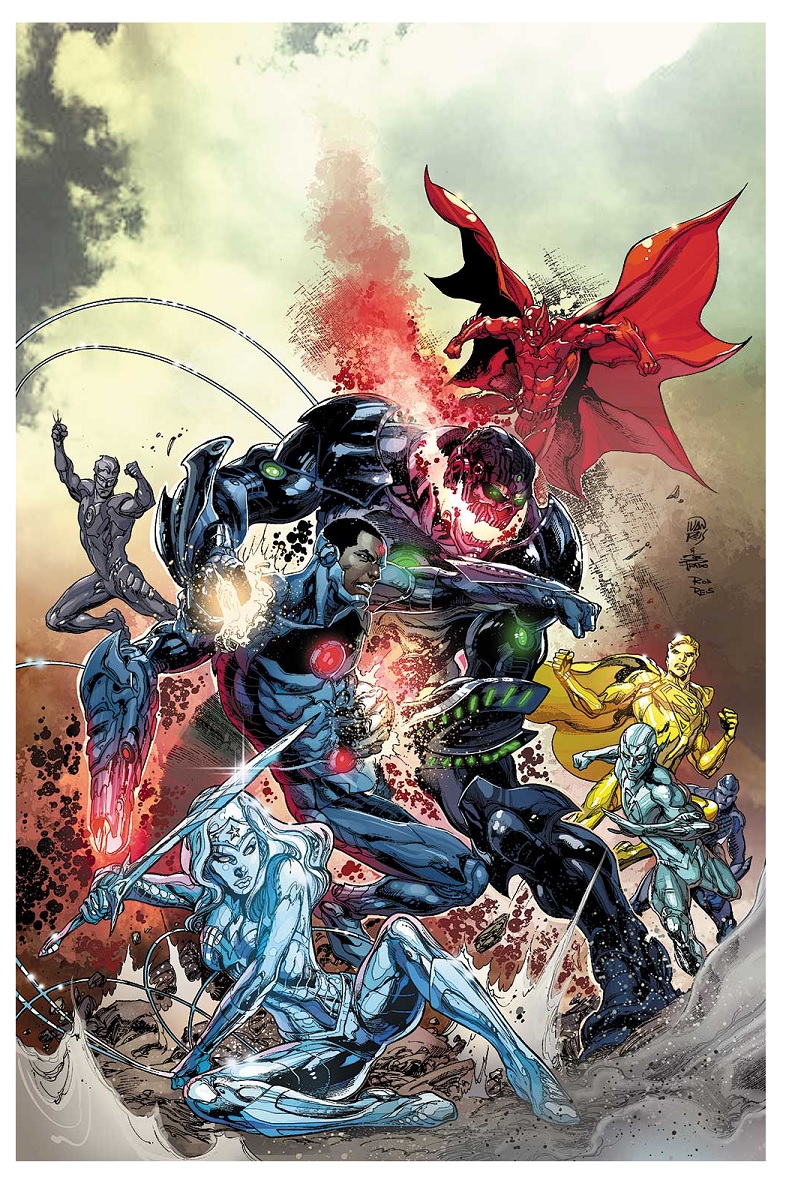
JUSTICE LEAGUE #29
Writer: Geoff JohnsArtists: Doug Mahnke
Publisher: DC Comics
Reviewer: Masked Man
As we wait for the final issue of FOREVER EVIL to come out, we can at least watch Cyborg and the Metal Men have their climatic battle. As you may recall, Cyborg talked their inventor Will Magnus into turning them back so they would help him defeat the Crime Syndicate, so they all head off to Happy Harbor and square off against the Grid--the computer virus somehow spawned by Cyborg becoming Cyborg.
For the most part this is a decent issue, much better than last issue. But for all the good showdown moments between Cyborg and the Grid, it still plays out as formula and then Johns always seems to adds these little details that make no sense to me (here come the spoilers):
-The Metal Men can be killed forever, if you destroy their responsometers--really? Magnus can't make more responsometers? How did he make them in the first place?
-The Grid wonders if he'll feel anything when he kills Cyborg. Odd, the Grid thought he had killed Cyborg already. So why does he think this time would be different?
-The 13 random supervillians that show up. Now I've been reading DC comics since 1985 and I can't even recognize all these characters--partly because it's the New 52 and they have all been redesigned, and partly because it's the New 52 and they haven't been introduced yet! For all we know, especially to a new reader, Johns could have said “just draw some superpowered thugs”, and Mahnke just made some up. Characters have no impact, have no threat, unless they have history--or at least a name (OK, he did say Hector Hammond, Dr. Psycho (who was in the THE TRINITY WAR), and the Fearsome Five--still didn't help me much).
Artwork-wise, it's hard to get better than Doug Mahnke, though I do find his work creepy--guy should be doing Batman or the 'dark' titles. Nearly every character who smiles in this book looks like they want to do depraved things to ya. Aside from that, it's a great-looking book. He also appears to be increasing his game to hang with the likes of Ivan Reis, JUSTICE LEAGUE's regular artist.
Lastly, I'll mention I think Johns missed an opportunity to do something interesting with the Grid (spoiler). He was an A.I. who joined the Crime Syndicate in an effort to learn how to feel. Upon meeting the Metal Men, he envies them, because they pretty much can. Now I know Cyborg needs his revenge and all, but I think it would have been more interesting if Magnus offer to help the Grid feel. Then he could have helped the heroes defeat the Syndicate, and become an interesting foil for the Metal Men to deal with.
Despite Johns best efforts, JUSTICE LEAGUE still really fails to deliver beyond broad strokes. As I've mentioned before, he seems to be in such a hurry to get to where he wants to (which seems to be re-populating the DCU) that it's all done rather sloppily.


ALL NEW DOOP #1
Writer: Peter MilliganArt: David Lafuente
Publisher: Marvel Comics
Reviewer: Henry Higgins is My Homeboy
Doop Doop Doop Doop, Doop Doop Doop.
I liked Peter Milligan's X-FORCE/X-STATIX well enough, but I certainly didn't love it. Nothing against the title, which was consistently funny, creative, and wholly unique in the world of superhero comics. It just never connected with me, the characters too unrelentingly dour, the plot lines too often scattershot across the place. Of course, I haven't read the title since it was originally coming out and I was much younger (and MUCH dumber), so I could just be spouting nonsense.
That ramble was all lead-up to this: the thing I will always remember and love from that title is Doop. The little green thing immediately stands out among the X-Men, with his bulging eyes and malicious smile. His stories are always surreal and inventive, and it's always a pleasure to see Milligan return to the little guy.
Milligan actually explores Doop a little here and gives him some new depth, as well as an explanation of what the hell he does; it turns out Doop is literally a marginal character, able to pop up whenever he feels like it but avoid all the necessity of "build up" or "structure". He pops in and out of the story when he's needed, much to the annoyance of Kitty Pryde, the only character who he makes his prescene known to. Doop operates in and around the recent "Battle Of The Atom" event, not really letting that plot dictate the story. Instead, this is a quick little look into who Doop is, and how he operates, namely popping in to do something necessary and then drifting away until he's needed again. Lafuente does a remarkable job conveying all this, at times having Doop literally dig his way through pages and end up on the other side. I don't mention the letterers nearly as much as I should, but Clayton Cowles is INCREDIBLE in this. Sound effects and changes in vocal tone are communicated with a startling ease, and working alongside Lafuente and Allred, the book ends up looking really good.
It's a light, fun, and wholly entertaining story. Especially if you like Milligan, ESPECIALLY if you like Doop, and really, if you enjoy fun comics.
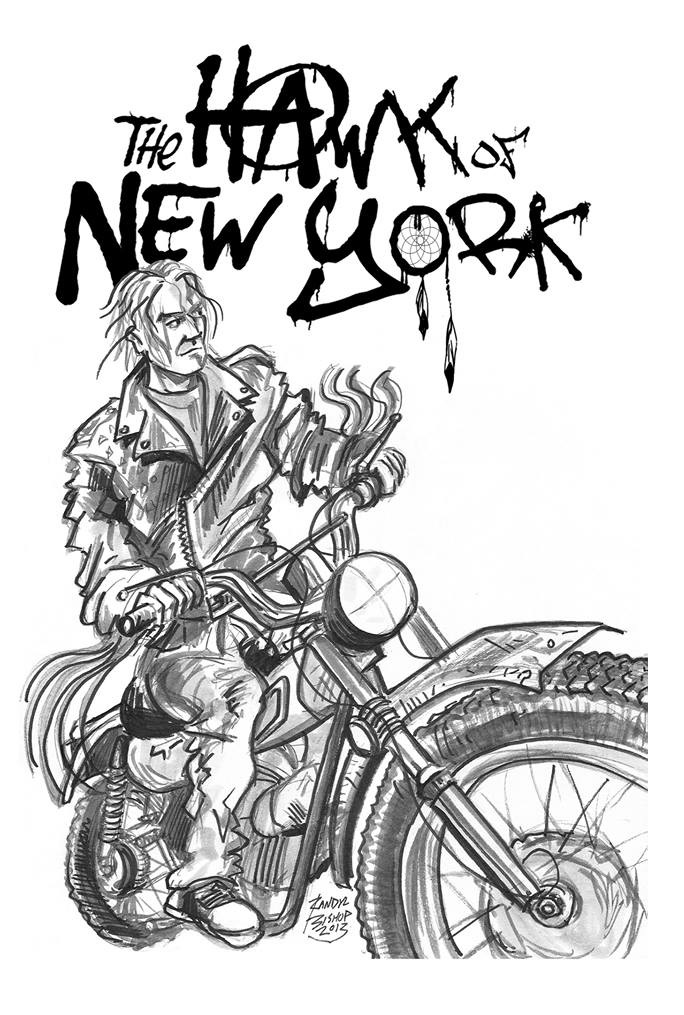 Indie Jones presents!
Indie Jones presents!THE HAWK OF NEW YORK #1
Writer: Randy L. BishopIllustrator: Randy L. Bishop
Publisher: Lunar Works Productions
Reviewer: Mr. Pasty
Eric Warden is a “half-Indian, half-white” orphan who grew up in the (corrupt) state system after being dumped on the doorstep of the Hendom County Orphanage in fictional Mohawk Springs, New York, wrapped in a leather jacket and holding a dreamcatcher. It's impossible to not think of Willowbrook State School (of CROPSEY fame) considering the locale/timeline and as expected, the Hendom experience is equally horrifying. But why is our protagonist able to survive and, dare I say, prosper? The answer lies somewhere within the yarn conceived by creator Randy L. Bishop. From Bruce Wayne to Annie, there's no shortage of rags-to-riches stories in pop culture and I think they're easy to relate to for a couple of reasons. Obviously, every abandoned child fantasizes of the day they become “someone”, but I think all kids have big dreams which, unless fulfilled, tend to tag along well into adulthood. I'm probably not going to play first base for the New York Yankees, but hey, I can still be General Manager!
What's interesting about THE HAWK OF NEW YORK is how each panel is layered with music, which might sound unusual for a comic, and I will admit it felt a bit cluttered in the beginning. Once I understood the correlation between the lyrics and the overall narrative – including Warden's growth as a character – it made a little more sense. So many mediums are using music these days to fill in the blanks, and that was one of my gripes about the last season of THE WALKING DEAD, a show that felt compelled to saturate every scene with country strings and wailing voices. That's not the case here, as Bishop is careful to construct each panel with a sense of purpose. The arrangement is not just “Hey, we have music!”, but rather a separate layer to help with exposition when Warden has nothing to say. He is a loner, after all, so we don't always know where his head is at, and like most loners or lost souls, he wraps himself in a blanket of lyrics to keep warm. It's a risky move in a comic, but one that pays off here thanks to Bishop's ability to put order above chaos.
As for the artwork, well, that's a little more difficult to describe. There is clearly a skilled pencil at work here, and if you take a long view of the page, it almost looks like the wall of a tattoo shop has come alive. Since Warden is “half-Indian” and the obvious "hawk" of New York, there exists a recurring and not-so-subtle placement of wings. Not just from birds and eagles, but also Warden himself, outstretched on gymnastics rings. He also floats in and out of dream states, casting a shadow of existentialism across the book's overall tone. Whether or not it's enjoyable to the reader depends on a number of qualifiers. THE HAWK OF NEW YORK bills itself as a coming-of-age tale featuring "murder, motorcycles, punk rock, and Indian magic", but I think anyone with a love for good music and quirky comics should check this one out. It's unique, well-paced, and just flat-out fun to read.
Web heads who can’t get enough of Mr. Pasty’s word vomit are encouraged to watch him operate as Nostradumbass over at MMaMania.com here. Love, hate and Mafia Wars requests should be directed here.
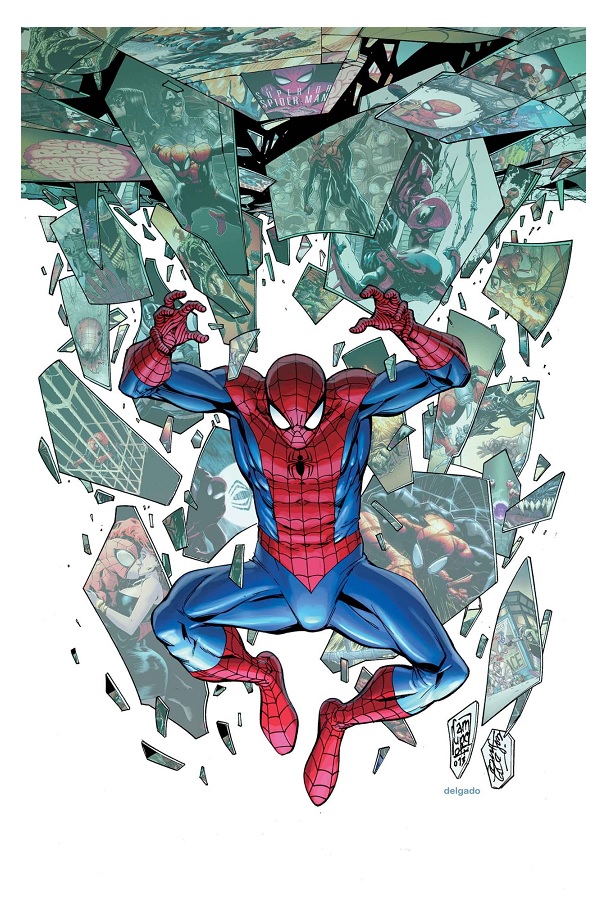
SUPERIOR SPIDER-MAN #31
Writer(s): Dan Slott and Christos GageArt: Giuseppe Camuncoli
Published: Marvel Comics
Reviewer: Mighty Mouth
Thirty-some issues ago ,Dan Slott rocked the comic community by killing off Peter Parker. In a move that some would parallel to rubbing salt in a wound, it didn’t stop there. Fans soon learned that the very villain responsible, Otto Octavius, would be taking control of Peter’s body (and title), carrying on his legacy as the SUPERIOR SPIDER-MAN. Needless to say, it was a bit of a risky move. SUPERIOR SPIDER-MAN #31 concludes this tale and returns Peter Parker as the one true Amazing Spider-Man.
Now back in his famous red and blue long johns, Peter races to undo the harm Otto carelessly created and free the city of the Goblin King’s reign. The stage has been set and all the players have been put in motion. So how does it all play out? The short answer: very rushed.
I don’t want to give the wrong impression. It’s not a bad issue; it’s just not the spectacular ending I was hoping for. I enjoyed Spidey’s confrontation with the Goblin King, and I’m curious to see how the twist this encounter brings will play out when next they face off. For me, what’s uninspiring about this conclusion rests in the lack of exposition regarding Otto’s mishandling of Peter’s mantle. It just feels a little too expedient for everyone from the Avengers to Aunt May to excuse Otto’s behavior as Peter and Spider-Man.
There is a back-up story that attempts to touch on this oversight. Regrettably, it didn’t do a whole lot for me. If anything, having Mary Jane reduced to a self-centered, approval-seeking louse pisses me off. I know Joey Q. feels that Spider-Man should be single and swinging (I know…that’s bad), but MJ and Peter should always be close, if not together. She’s easily one of the few supporting characters in a superhero comic that’s more than just a love interest. You don’t want to squander that.
These last few issues have been more of a collaborative effort, with Slott managing the plot points while Gage took the scripting duties. Perhaps just as too many chefs can spoil a broth, too many writers can diminish the story. Or maybe Slott shifted his concentration to the upcoming AMAZING SPIDER-MAN book? Whatever the case, the result is the same; what could have been a fantastic finish to an impressive undertaking turns out to be just okay.
At the end of the day, SUPERIOR SPIDER-MAN #31 serves its purpose, restoring Peter Parker to his rightful place and confirming that he was always the superior web-slinger. In general I did enjoy this book, and kudos to Slott and company for being able to keep the momentum for this long. I just hope when Marvel launches AMAZING #1 there will be some lingering matter for Peter and his supporting cast to sieve through. Something this major shouldn’t be dealt with such hurriedness.

BATMAN #30
Writer: Scott SnyderArtist: Greg Capullo
Publisher: DC Comics
Reviewed: Humphrey Lee
We all know by now the probably most famous, non-Joker line from Christopher Nolan’s “The Dark Knight” about the hero living long enough to see them becoming the villain. Unfortunately, this tends to happen with some entertainment storylines too (or in this case we’re talking comic book runs) where a good thing just pushes things a little far or overstays its welcome to the point of being superfluous. Or, hell, given the world of comics, you begin to wonder how some of these story arcs fit into the grand scheme of things and the continuity of it all. As you can guess by my even bringing up all this shit in the first place, that’s kind of where my take on this usually pretty stellar run of BATMAN has gotten itself.
No, my waning enthusiasm toward the current state of this book has nothing to do with any idea of diminishing returns from another “Batman as a rookie” story session. In fact, I usually enjoy these “how the legend began” tales, as long as someone is able to appropriately bundle up the mythos a little tidier (or messier, depending on what you want out of a story featuring a Batman that’s severely less polished than he is now) and maybe intertwine some character relationships or show some tidbits that change some dynamics in the great Batmanverse. And it had nothing to do with Snyder and crew reaching for a whole year to tell this tale in general, at least at the onset, as long as it also did those things I mentioned above. But now that we’re quite a bit into his ZERO YEAR tale I do find myself wavering a bit as I’m finding the overall story tedious and, quite honestly, a little brazen in its scope.
I say “brazen” because it feels like a pretty far reach to take that first time Batman action – which, again, I usually enjoy – and put it essentially in the middle of, like, “No Man’s Land” meets THE DARK KNIGHT RISES with The Riddler having basically cut Gotham off from the rest of the world and thrown it back into a Stone Age of a sort where everyone is going native on each other’s asses. That just feels WAY too big to me in a couple regards. One in the aspect of we’re two and a half years into this new run now and not once has anyone bothered to drop a random line of “man, these guys in the Owl masks are crazy, but remember that time Riddler basically set our society back two years?” and two, for a character that was apparently an under the radar urban legend before the events of the first JUSTICE LEAGUE arc, getting involved in a grim scenario involving a mass cutoff from the world and giant death blimps and so on. I get it: it’s comics--I’m probably overthinking things, and I know this is a great way to immediately add to the legend of the Dark Knight, but it just plays to me as cacophonous and drowning out more of the heart of this character when he’s earning his stripes rather than being the unflappable scourge of the underworld he becomes.
Despite all that, though, which probably came off whinier than I really want it to be (“Wah! This isn’t the way I usually like things even though it is structurally well executed!”), it still plays well because Snyder does have the character bits coming out just about right. The doubtful Jim Gordon who now has to be more than he was as the stakes escalate for him as well, that early relationship between Bruce and Alfred as the latter is still coming to grips with what the former is trying to become, and the level of megalomaniacal that the Riddler gets played is pretty juicy in that scenery-chewing kind of way (even if it does result in an almost unbearable amount of text for a couple of pages in the middle of the issue).
It’s an enjoyable Batman and supporting cast depiction, it’s a solid Batman story, it’s a clusterfuck of context and continuity given what the issues preceding this and the New DCU have mentioned about this event (nothing) and Batman’s place in the world (shadowy figure who ran for five years in the dark but is all over the place here in his first go). But since DC itself does not seem to care about their overall picture since they’ve put it in a new frame, it’s more the context of this BATMAN book proper I care about, and such an epic yet derivative storyline feels very awkward coming before the likes of the “Court of Owls” and the last Joker tale, as this is almost blatantly higher stakes than those two arcs played for and the Bat is just a…whatever you call a baby bat here. I think the personality exploration and the action have held it all together well so far, but this is one of the rare occasions where I find myself wishing a story’s scope to be pulled back a notch or two, especially at a time where the “alternative” is a $12 a month year long epic going on in BATMAN ETERNAL. Sometimes simple is good and the original way to go about something.
Humphrey Lee has been an avid comic book reader going on fifteen years now and a contributor to Ain't It Cool comics for quite a few as well. In fact, reading comics is about all he does in his free time and where all the money from his day job wages goes to - funding his comic book habit so he can talk about them to you, our loyal readers (lucky you). He's a bit of a social networking whore, so you can find him all over the Interwebs on sites like Twitter, Facebookand a blog where he also mostly talks about comics with his free time because he hasn't the slightest semblance of a life. Sad but true, and he gladly encourages you to add, read, and comment as you will.
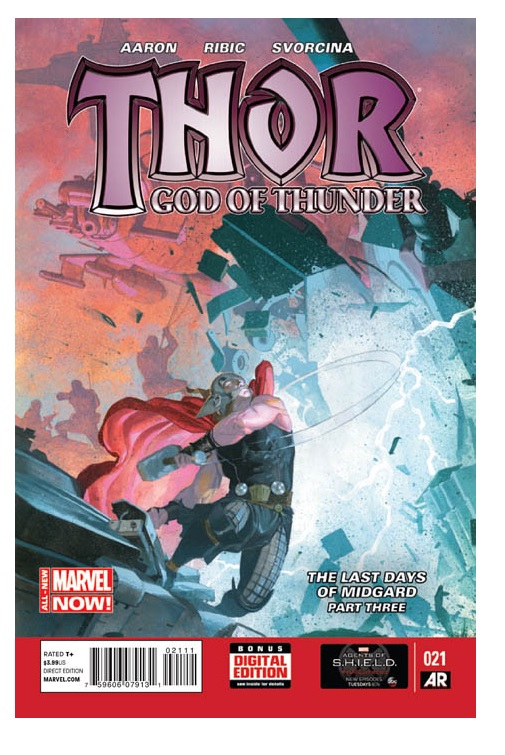
THOR: GOD OF THUNDER #21
Writer: Jason AaronArtists: Esad Ribic
Publisher: Marvel Comics
Reviewer: Masked Man
First off, it's good to see Esad Ribic (powered by Ive Svorcina's colors) back on the book. As we all know, when a great writer/artist team gets together, they never seem to last long, so it's good to see Jason and Esad still working together on Odin's Son. Storywise, Aaron is putting together an interesting dual story of modern day Thor and future King Thor (seems Aaron was having too much fun with him last time, so he's back for more—personally, I'd like to see his daughters more too. They can be a fun new take on the Warrior's Three).
Now some of you may remember I ragged on INFINITY because it was pretty much two unconnected stories in one series, so I'll explain why it works here. Basically, it boils down to character defining. In each story, Aaron is showing no matter how much has changed with King Thor--older, wiser, stronger, eyeless, armless, whatever--he's still the same dumb, pig-headed guy. In modern day, Thor is going up against Roxxon, who is your typical evil corporation out to poison the Earth in the name of profit. Future King Thor is going up against Galactus, who has come to finally eat what's left of the dead Earth. So the stories even have the same theme: Thor's love of the Earth. In both cases Thor appears to be out of his depth, maybe even fighting a losing battle, but that doesn't stop Thor from being Thor. Now while the future story is played mostly for fun, as King Thor and Old Galactus trade blows (the poor moon can never catch a break), the present story attempts to modernize the types of attacks against Thor, as Roxxon sues him and buys up his favorite little city, Broxton, just to f' it over. This I find interesting and hope Aaron doesn't wimp out on. Like, can you really sue a god? What happens when you put out a warrant out on Thor because he decides not to appear in court? A lot of cool things can come out of this, and I hope Aaron really goes for it.
To talk about the art for this issue, Ribic and Svorcina are really masters of atmosphere. The scenes of King Thor and Old Galactus smashing the crap out of each other are pretty awesome, especially when you see how King Thor f's up Old Galactus' face--great stuff. Being a grumpy old reader, THOR: GOD OF THUNDER is one of the few titles I actually enjoy reading month-in and month-out (as opposed to mildly amused and just giving something a chance).
Lastly, really lastly, the supervillain who appears on the final page has always been of favorite of mine. The old master John Buscema used to draw him as muscles on top of muscles. Just the perfect little fire plug of mayhem, designed to go ten rounds with the god of Thunder--so I'm quite happy to see the CEO of Roxxon, Dario Agger, has hired him as a bodyguard.

SHE-HULK #3
Writer: Charles SouleArt: Javier Pulido
Publisher: Marvel Comics
Reviewer: Optimous Douche
I don’t review a lot of Marvel books because they rarely meet my two mantras of the publishers or creators care about the press and will share it for social reach and, more importantly, you fan-type folks give a shit about what I say. I’m breaking the rule with SHE HULK because I have followed Soule since his start with Valiant, and I don’t hear a lot of you zombies already chattering about the sheer awesomeness of this book.
Now, I’ll start with the other caveat that I am a sucker for law firm comedy and drama. I have seen them all, even when I was a very weird kid for wanting to be home for L.A. LAW each week. Over the years I have found the melding of law and comics so alluring because it helps ground the books. It gives them those sparks of reality that help make the comic world feel more real and thus deliver a greater impact when the characters experience trials (har har) and tribulations.
I was worried about how Soule would handle comedy and add the necessary authenticity to Ms. Walters’ life when not engaging in green fisting. The last time we saw SHE HULK in a solo story she was in the hands of guffaw master Dan Slott, and I coveted that series as much as my DVD collection of BOSTON LEGAL. Now, I’m not sure if Jennifer has matured or Soule is simply a more mature writer, but at only three issues in I will put this series on par with or better than its predecessor.
Part of my rapture lies in this series being more starkly real. In Slott’s run the firm was zanier than all of the ALLY MCBEAL episodes combined. Yes, Awesome Andy was awesome, and using comics as legal briefs was a groovy touch, but it killed aesthetic distance. I knew no law firm could survive those kinds of shenanigans. Soule takes Jennifer into private practice after telling the fatcat partners at her last firm to pound sand by pounding their mahogany conference table to pieces. Issue two saw Jennifer set up shop in a very unique building that only rents space to superheroes performing mundane day jobs. There’s also a very nice touch to continuity by making Jen’s landlord a victim of M day, and thus sympathetic to the superhero plight. The second issue also gave us an introduction to Jen interviewing paralegals. She settles on a deadpan woman with a special monkey helper. Why a monkey? Who gives a shit? It’s a fucking monkey with a secret working in a law firm. This is as stellar as the Valiant goat, in my humble opinion.
Jen also gets her first client in the second issue: the son of Victor Von Doom. Here is where the book transcends good and leaps into greatness. The son of the dictator is seeking asylum in the Merica, from…wait for it…oppression.
A lesser writer would have had this arrogant douche commit some kind of felony, but Soule twists matters, making Doom Jr. a victim of royal persecution…or I guess it would be persecution from royalty. Faced with a life of being a dictator’s successor or dying, he chooses freedom on our shores. One snafu, though-today is the one year mark on his visa, and that’s all the time anyone has to apply for official asylum.
Issue 3 is pure comic booky as Jen and Doom Jr. try to make it to the courthouse by 5:00 PM while being thwarted at every turn by Doombots. Hellcat is Jen’s feet on the street and pulls a perfect ruse to get them to court on time…sorta.
That’s enough spoilers for now; I hope I have entreated you to enjoy the human and heart of SHE HULK. The art is also stellar--Pulido is like Allred with the ability to draw characters that actually look different from one another. While I’m more of a fan of the sultry SHE HULK, even I can’t deny that Pulido’s style is a perfectly quirky fit for a perfectly quirky book.
Proofs, co-edits & common sense provided by Sleazy G
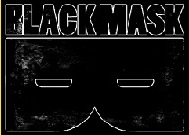 Find out what are BLACK MASK STUDIOS and OCCUPY COMICS here and on Facebook here!
Find out what are BLACK MASK STUDIOS and OCCUPY COMICS here and on Facebook here! Want more in all things Geek?
Want more in all things Geek?Check out PoptardsGo and on Facebook here!
Check out AICN COMICS on Facebook and Comixpedia!
